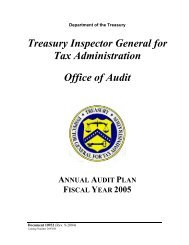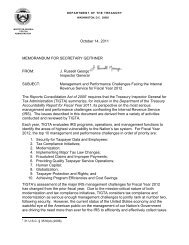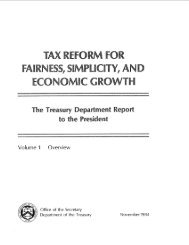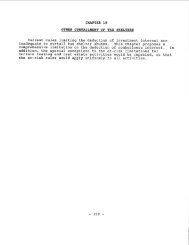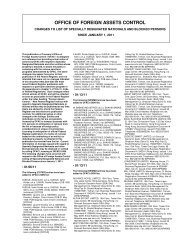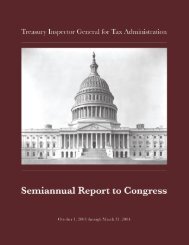PDF - Department of the Treasury
PDF - Department of the Treasury
PDF - Department of the Treasury
You also want an ePaper? Increase the reach of your titles
YUMPU automatically turns print PDFs into web optimized ePapers that Google loves.
Number (EFIN), 10 as required, for<br />
electronically-filed tax returns.<br />
Additionally, TAC assistors correctly<br />
answered only 66 percent <strong>of</strong> <strong>the</strong> 196 tax<br />
law questions TIGTA auditors asked during<br />
<strong>the</strong> 2005 Filing Season. This was a<br />
nominal improvement from 2004 results,<br />
but <strong>the</strong> IRS has not yet achieved its<br />
FY 2005 accuracy rate goal <strong>of</strong> 81 percent.<br />
Several performance measures in toll-free<br />
telephone service also declined during <strong>the</strong><br />
2005 Filing Season. For 4.3 million tax<br />
law and 9.3 million account-related<br />
assistor-answered calls, <strong>the</strong> percentage <strong>of</strong><br />
taxpayers who received services within<br />
30 seconds (Assistor Response Level)<br />
decreased, and <strong>the</strong> average number <strong>of</strong><br />
seconds taxpayers waited in <strong>the</strong> queue<br />
before receiving services (Average Speed<br />
<strong>of</strong> Answer) increased. In addition, <strong>the</strong><br />
Secondary Abandon Rate (in which a<br />
taxpayer navigated <strong>the</strong> automated menu<br />
and <strong>the</strong>n disconnected while waiting to<br />
speak to an assistor) increased from <strong>the</strong><br />
2004 Filing Season.<br />
TIGTA recommended that <strong>the</strong> IRS develop<br />
a partnership between <strong>the</strong> TACs to share<br />
best practices and a process to ensure that<br />
each TAC is assigning a unique EFIN.<br />
TIGTA made no recommendations for <strong>the</strong><br />
o<strong>the</strong>r weaknesses identified because <strong>the</strong>y<br />
had already been outlined in prior reports.<br />
IRS management agreed with <strong>the</strong><br />
recommendations provided.<br />
Report Reference Nos. 2005-40-146, 2005-<br />
40-147, 2005-40-152, and 2005-40-155<br />
Erroneous Payments<br />
Refund fraud committed by prisoners is<br />
growing at an alarming rate. The number<br />
<strong>of</strong> false returns from prisoners identified by<br />
<strong>the</strong> IRS grew from 4,300 returns during<br />
Processing Year (PY) 11 2002 to over 18,000<br />
returns during PY 2004 – a 318 percent<br />
increase. Resources and incomplete and<br />
inaccurate prisoner data may be preventing<br />
<strong>the</strong> IRS from detecting more fraudulent<br />
prisoner returns. IRS Fraud Detection<br />
Centers (FDC) do not have <strong>the</strong> resources to<br />
physically screen all prisoner returns.<br />
During PY 2004, FDCs screened about<br />
36,000 <strong>of</strong> <strong>the</strong> 455,000 prisoner refund returns.<br />
TIGTA identified over 18,000 prisoners<br />
during Calendar Year 2003 who filed<br />
returns with a filing status <strong>of</strong> ei<strong>the</strong>r “single”<br />
or “head <strong>of</strong> household” while claiming<br />
more than $19 million in EITC. In<br />
addition, TIGTA’s analyses <strong>of</strong> <strong>the</strong><br />
2.8 million prisoner records on <strong>the</strong> 2004<br />
prisoner data file identified about<br />
550,000 records that were ei<strong>the</strong>r incomplete<br />
or missing.<br />
Prison <strong>of</strong>ficials expressed frustration with<br />
<strong>the</strong> IRS’ inability to share information on<br />
prisoner refund fraud. This is because<br />
Internal Revenue Code (I.R.C.) § 6103 (2004)<br />
generally prohibits <strong>the</strong> IRS from sharing<br />
Federal tax information, except under<br />
limited circumstances. Two Members <strong>of</strong><br />
Congress have called for more information<br />
sharing and better enforcement measures,<br />
such as allowing <strong>the</strong> IRS to share tax<br />
10 An EFIN is a number assigned by <strong>the</strong> IRS to<br />
identify which Electronic Return Originator<br />
originated <strong>the</strong> tax return.<br />
11 Processing year refers to <strong>the</strong> year in which<br />
taxpayers file <strong>the</strong>ir tax returns at <strong>the</strong> Submission<br />
Processing sites. Generally, returns for 2003 were<br />
processed during 2004, although returns for older<br />
years were also processed.<br />
April 1, 2005 to September 30, 2005 15





